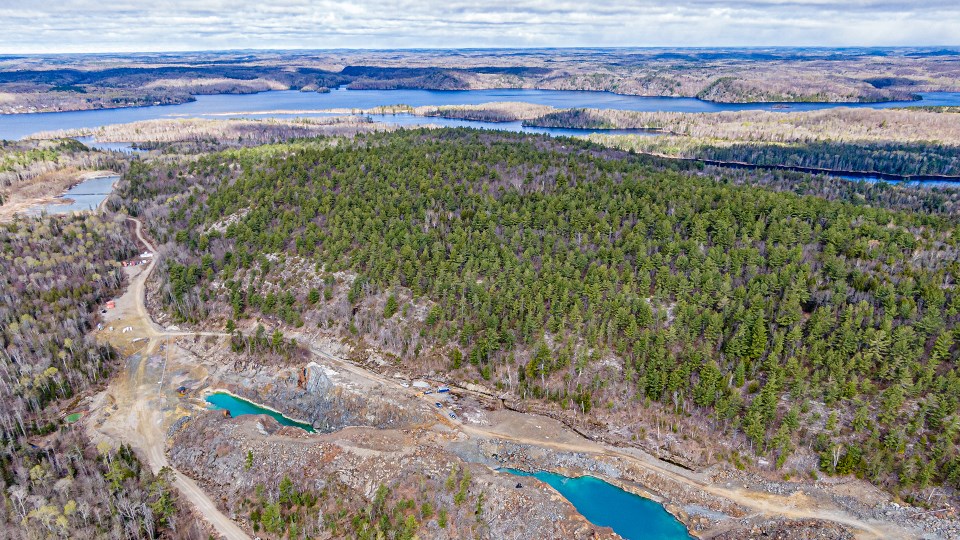Areas outside the Sudbury Basin are proving to be fertile ground for junior mining exploration companies probing for precious, base and so-called 'green' metals. Two projects are showing definite mining potential.
New Age Metals expects to release a pre-feasibility study this summer for a proposed open-pit mine at its River Valley project.
Situated on a 15,800-acre property 100 kilometres east of Sudbury and north of the town of Warren, the Vancouver junior miner maintains it could be a multi-million ounce producer of platinum group metals.
The plan is for a pit operation that would extract 119,000 ounces of palladium per year over 14-year mine life. The pricetag to build it is $495 million.
Palladium is the primary metal at River Valley, making up 63 per cent of the deposit. Palladium is used in automobile catalytic converters and is a hot commodity these days, currently trading in the US$1,850-per-ounce range.
The makeup of the rest of the deposit is 17.5 per cent platinum, 12.9 per cent copper, with gold and rhodium in the mix.
Sign up for the Sudbury Mining Solutions weekly newsletter here.
New Age, once known as Pacific North West Capital, acquired the property in 1998 from some prospectors. For a decade, the company was in a joint venture with Anglo Platinum up until 2008 when the financial crisis hit and Anglo left the partnership. Up until that time, Anglo invested $30 million in River Valley.
New Age eventually regained full ownership in the project in 2010. Stronger palladium prices kickstarted exploration in 2017.
The company put out a new mineral resource in 2019 and a preliminary economic assessment.
A pre-feasibility study (PFS), started last April, is due out in June or July. A PFS is a middle engineering step to evaluate the technical and economic viability of a mining project.
Since acquiring the property in 1998, the company has drilled more than 700 holes over a 16-kilometre zone, down to an average depth of 220 metres. The deepest hole has been 600 metres where they've found mineralization.
In a recent Renmark Virtual Road Show web presentation, Cody Hunt, the company's vice president of business development, said they're still viewing River Valley as pit operation, but there's "lots of exploration upside."
Plans for 2022 at the site involve ongoing site geochemical and hydrological engineering work and advanced environmental baseline studies to fold into the prefeasibility and future permitting.
Hunt said they will have more news shortly on their exploration plans for 2022.
"Certainly," Hunt said, "it's going to be a very busy year for the company at River Valley."
Want to read more stories about business in the North? Subscribe to our newsletter.
The company has an agreement with Temagami First Nation, dating back to 2014, to provide training and employment through the exploration phase.
West of Sudbury, Magna Mining wants to bring the former Shakespeare Mine property back into production.
The company has been drilling around the spot where it wants to build an open-pit mine, 60 kilometres southwest of the city, and is looking to extend the size of its nickel, copper, and platinum group metals deposit.
The Shakespeare Mine operated briefly, between 2010 and 2012, but Magna believes there's more mineral potential to be had on the 180-square-kilometre property. The site is permitted for a 4,500-tonne-per-day open-pit mine and processing plant operation.
The property is located to the north of the town of McKerrow.
The current resource is estimated at 14.4 million tonnes at 0.34 per cent nickel, 0.37 per cent copper and 0.9 grams per tonnes, all in the indicated category.
The company has been drilling to fill in the gaps between its East and West Zones at Shakespeare, and recently released a batch of encouraging assay results. They're also searching for mineralization further out from the deposit.
Since May, the company has carried out 8,700 metres of drilling and made a promising new nickel, copper and platinum metal discovery called the P-4 target, which will be drilled off this year.
The company expects to post a mine feasibility study over the next few months for a development with "low upfront capital cost and a fast track to production."
“The 2021 drilling results to date are very encouraging," said Mynyr Hoxha, vice president of exploration in a news release. "The Shakespeare deposit has significant potential to grow along the strike to the east and west, and is open at depth."
Toronto's Inventus Mining is an exploring an area east of the Sudbury Basin that the company suspects could be geologically related to the Sudbury Igneous Complex.
At its Sudbury 2.0 and Pardo Projects, the company has been drilling and finding gold, copper, nickel and cobalt.
The company moved a drill rig to a spot at its Sudbury 2.0 Project called Cobalt Hill where they marked a gold, cobalt and nickel target to begin a 4,000-metre drill program.
Sudbury 2.0 project consists of 240 square kilometres of mineral claims.
The area, dubbed the Temagami Anomaly, was staked and extensively surveyed by Falconbridge in the 1990s without success.
At its Cobalt Hall and Lake Zone, the mineralization they've found resembles an iron oxide-copper-gold ore system believed to be enriched with gold, copper, cobalt, nickel and rare earth elements.
To the southeast, Inventus pulled a 6,000-tonne bulk sample from the 007 Zone at its Pardo Project, where channel samples last summer revealed gold, the best being 47.9 grams per tonne over 1 metre. The bulk sample was crushed and being shipped to the Redstone Mill in Timmins this winter.
A bulk sample is a large volume of mineral material extracted to determine its physical and chemical properties. This analysis is used to assess the viability and options for a potential mining development.




